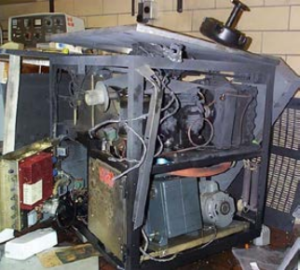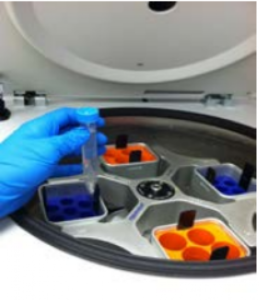The centrifuge is a commonly used tool in laboratory research. It uses centrifugal force to separate substances in liquid or solid media according to particle size and density differences.

What are the hazards?
If used and/or maintained improperly, all centrifuges (including microcentrifuges) can present various hazards:
- Physical hazards: Mechanical failure due to mechanical stress, metal fatigue, and corrosion of the rotor over time
- Exposure hazards: Aerosolization of biohazardous, chemical, or radioactive materials
How can I protect myself?
The following information may be integrated into a lab-specific standard operating procedure (SOP) for centrifuge use.
Preventive Maintenance
 Establish a preventive maintenance schedule: Including regular cleaning of centrifuge interior to prevent damage and avoidcostly repairs. Reference centrifuge operator’s manual or contact manufacturer for guidance. Equipment repair and adjustments shall only be conducted by qualified service technicians.
Establish a preventive maintenance schedule: Including regular cleaning of centrifuge interior to prevent damage and avoidcostly repairs. Reference centrifuge operator’s manual or contact manufacturer for guidance. Equipment repair and adjustments shall only be conducted by qualified service technicians.- Maintain a log book: For all high speed centrifuges and ultracentrifuges include run dates, durations, speeds, total rotor revolutions, and notes on rotor condition.
Retire rotors after manufacturer’s recommended life span except where annual stress test demonstrates absence of structural flaws. Note: Rotor life span may be reduced or warranty voided if autoclaved; contact manufacturer for guidance.
Planning for Use
- Complete lab-specific training for the centrifuge.
- Wear appropriate PPE: Including safety eyewear, gloves, a lab coat, and appropriate street clothing (i.e., long pants and closed-toe shoes). Ensure gloves are compatible with hazard(s).
- Inspect centrifuge:
- Ensure tubes are rated for intended use (speed, temperature, and chemical resistance)
- Rotor is compatible with centrifuge and seated on drive correctly
- Rotor and safety cups/buckets are free of cracks and deformities
- Rotor O-ring is not cracked, missing, or worn
- Safety cups/buckets are attached correctly and able to move freely
- Contact a qualified service technician if inspection identifies centrifuge components requiring repair or replacement.
 Prepare centrifuge tubes for loading:
Prepare centrifuge tubes for loading:
- Inspect centrifuge tubes before use.
- Follow manufacturer’s filling limits for tubes. Do not overfill or underfill tubes.
- For biohazardous materials, disinfect outside of tubes prior to removal from biosafety cabinet and loading into rotor.
- When centrifuging hazardous materials, use tightly capped tubes and/or sealable safety cups or rotors that can be loaded and unloaded in a fumehood or biosafety cabinet, depending on hazard. If a specific procedure does not allow for this, contact EH&S at (650) 723-0448 for guidance.
- For high speed centrifuges and ultracentrifuges, use an in-line filter in the vacuum line to prevent contamination of the vacuum pump and pump oil. Provide secondary containment for vacuum pump.
Centrifuge Operation
- Balance centrifuge.
- Start run
- Do not leave centrifuge until full operating speed is reached and appears to be running safely without incident.
- Stop centrifuge immediately if you notice any unusual noises or shaking. Confirm rotor is balanced.
- To prevent rotor failure, do not exceed maximum speed and maximum mass limits for the rotor. You must reduce rotor speed if sample density calculations indicate maximum mass limits will be exceeded; contact manufacturer for guidance
Sample Removal
- Stop run: Ensure centrifuge comes to complete stop before opening cover. When centrifuging hazardous materials, wait at least 10 minutes after run to allow aerosols to settle before opening centrifuge.
- Check for leaks/spills: In samples, rotor, safety cups/buckets, and centrifuge well.
- Open sealable tubes/safety cups/rotors: Wear appropriate PPE and open inside fumehood or biosafety cabinet, depending on hazard.
Emergency procedures
Mechanical Failure
- Turn off centrifuge immediately and unplug power cord.
- Do not use centrifuge again until inspected by qualified service technician.
Hazardous Material Spill/Exposure
- Turn off centrifuge immediately.
- Keep centrifuge cover closed for at least 30 minutes to reduce aerosolization of hazardous material.
- Follow spill, exposure, and incident reporting instructions.
- For chemicals see here.
- For biohazardous materials see the Biosafety Manual.
- For radioactive materials: call the Health Physics Program at (650) 723-3201 or (650) 725-9999 (after hours).
Remember:
- Conduct rotor or safety cup/bucket cleanup in nearest biosafety cabinet or fumehood, depending on hazard.
- Use tongs or forceps to avoid contact with sharp-edged debris.
- Avoid alkaline cleaners for aluminum centrifuge components.
- Avoid abrasive wire brushes for cleaning.
How do I dispose of this?
For biohazardous materials, clean/disinfect centrifuge and remove/cross out biohazard sticker. Attach note on centrifuge describing what has been done.
For radioactive materials, request radiation safety survey and signage before disposal of centrifuge.
